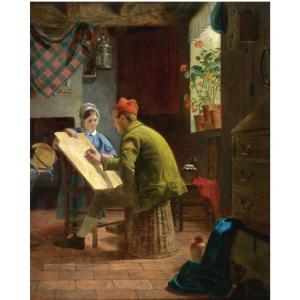The Rise of Victorian Paintings Pt. 5 – artmarketblog.com

JAMES COLLINSON 1825-1881 THE WRITING LESSON 50,000—70,000 GBP Lot Sold. Hammer Price with Buyer's Premium: 79,250 GBP
Prior to the Scott Sale, Grant Ford, Senior Director and Head of Victorian Art at Sotheby’s,made the comment that: “Sotheby’s is delighted to be bringing this extraordinary collection to the market. Victorian narrative works are the cornerstone of the collection and not in all my time at Sotheby’s – a period of 22 years – has a collection of this quality come on to the auction market. The Scotts were collectors in the truest sense; they had an individual and discerning taste and they only ever bought paintings that they truly loved and understood and which said something special to them. We look forward to exhibiting this wonderful collection around the world and are sure that the single-owner sale in November will be a real highlight of the Autumn sales calendar.”
Even though the odds were heavily stacked against Sotheby’s, the sale of the Scott collection was a major success for the auction house, and a huge victory for the market for Victorian art. A total of 87.6% of the lots sold for a grand total of £4,620,071 against an estimate of £4.1-6.2 million brining the sold by value percentage to 77.6%. Most impressively, a total of at least fourteen new artist auction records were established the most impressive of which was achieved for Sophie Anderson whose ‘No Walk Today’ fetched just over £1 million against an estimate of £600,000-800,000. New auction records were also set for William Dyce, John Calcott Horsley, William Somerville Shanks and Thomas Sword Good among others. A total of 280 bidders took part in the sale many of whom were European collectors and investors which is unusual for a genre that would usually only attract British collectors. Considering the importance of the collection and the provenance of the paintings, however, it is not that surprising that many of the works were purchased by Europeans.
After the sale Ford is quoted as having said Commenting on the sale, Grant Ford, Senior Director and Head of Victorian Art at Sotheby’s, said: “This historic collection has attracted an enormous amount of attention from collectors all over the world but especially from our established clients in the UK. As many of the paintings had not been seen in public for several decades and were in a wonderfully fresh condition, a great deal of excitement was generated. We haven’t seen the galleries and saleroom – here in London particularly – as full and busy for a Victorian picture sale in many years. We are absolutely delighted with the new world record price for Sophie Anderson, which fully establishes No Walk Today as one of the most important childhood subjects of its time, and we’re also thrilled and heartened by the many other world record prices achieved. Today’s results are a testament to the discerning eye of two individuals who were collectors in the very truest sense.”
To be continued……..
Part 1:
http://artmarketblog.com/2010/02/25/the-rise-of-victorian-paintings-part-1-artmarketblog-com/
Part 2:
http://artmarketblog.com/2010/03/04/the-rise-of-victorian-paintings-pt-2-artmarketblog-com/
Part 3:
http://artmarketblog.com/2010/03/11/the-rise-of-victorian-paintings-pt-3-artmarketblog-com/
Part 4:
http://artmarketblog.com/2010/03/18/the-rise-of-victorian-paintings-pt-4-artmarketblog-com/
 **Nicholas Forrest is an art market analyst, art critic and journalist based in Sydney, Australia. He is the founder of http://www.artmarketblog.com, writes the art column for the magazine Antiques and Collectibles for Pleasure and Profit and contributes to many other publications
**Nicholas Forrest is an art market analyst, art critic and journalist based in Sydney, Australia. He is the founder of http://www.artmarketblog.com, writes the art column for the magazine Antiques and Collectibles for Pleasure and Profit and contributes to many other publications
Filed under: art, art investor, art market, arts, auction, victorian art, victorian paintings | Tagged: art, art auction, art market, artist, victorian art, victorian paintings | 1 Comment »

















 Back to the Sun, 40″ x 48″, oil on wood.
Back to the Sun, 40″ x 48″, oil on wood.  Match Book, altered book, ink and matches.
Match Book, altered book, ink and matches.  faulter, 60×60, acrylic on plastic bags.
faulter, 60×60, acrylic on plastic bags.  A little while ago I wrote a post about rise of the value of Surrealism. That post was an general introduction to the Surrealist movement so I will now, in continuation from the last post, explain the factors that have led to an increase in the popularity and value of Surrealist art. If you haven’t read the previous post on Surrealism you can do so here:
A little while ago I wrote a post about rise of the value of Surrealism. That post was an general introduction to the Surrealist movement so I will now, in continuation from the last post, explain the factors that have led to an increase in the popularity and value of Surrealist art. If you haven’t read the previous post on Surrealism you can do so here:
























